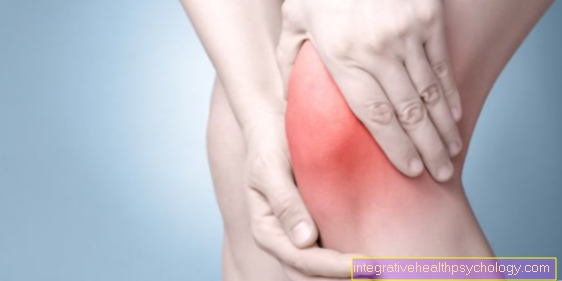bump on the head
introduction
A bump on the head is colloquially any form of swelling that can be felt or even seen with or without a recognizable cause.
Often there is an increased accumulation of fluid in the tissue, which can easily arise as a result of an injury to the head due to the thin padding of the skull bone. In most cases, bumps on the head are harmless and do not require special treatment.
Under certain circumstances, however, prompt medical clarification is recommended so that any necessary therapy can be initiated in good time.

causes
In the case of a bump on the back of the head or at another point on the head, it makes sense to classify the causes according to whether there is a trigger for the swelling or whether it has arisen for no apparent reason. Most often, bumps develop as a result of an injury to the head. It is easy to hit or bump your head on an edge in everyday life or when doing sports. A fall on the head usually also leads to the formation of a bump in the affected area.
There are many causes for bumps on the head that arise without a direct trigger, but overall less common than those that arise as a result of an injury. A distinction must be made between enlarged lymph nodes, which can occur mainly on the back of the head or neck, but also under the lower jaw or in front of or behind the ear.
In addition, bumps can occur due to benign adipose tissue growths (lipomas) or a purulent inflammation of a hair follicle.
Other possible but rare causes of bumps in the head can be diseases of the salivary glands, skin or bones. In general, benign diseases are much more common.
Only in extremely rare cases does a bump on the head hide a malignant disease. It is therefore advisable to have a bump promptly examined by a doctor if it has no apparent cause, has persisted for more than two weeks or is getting bigger and bigger. This can either give the all-clear or promptly initiate further diagnostics and any necessary therapy.
The most common causes of bumps on the head are discussed in detail below.
also read: Boils on the head
Fall
A fall on the head or the back of the head usually leads to the formation of a bump.
The peculiarity of the head is that the bony skull is only surrounded by a thin layer of soft tissue, consisting of skin, subcutaneous fatty tissue and in part a thin layer of muscles and tendons. In the case of a blunt injury, such as a fall, this tissue is compressed because the bone does not give way. As a result, tissue water escapes into these layers, which then leads to the usually visible and palpable bump on the head and is usually associated with pain.
It is best to cool the affected area as soon as possible after the fall and keep your head in an elevated position, for example by sitting down or lying down with your upper body elevated. This will keep the size of the bump as small as possible.
Depending on the size of the bump, it usually recedes within a few days and heals without any consequences. If the fall also resulted in a head laceration, or if further injuries occurred, you should see a doctor. The same applies if symptoms such as dizziness, impaired consciousness or nausea occur after the fall.
More on this: Laceration on the head
Lipoma
A lipoma is a benign increase in the fatty tissue under the skin.
A lipoma can basically appear anywhere on the body. This is often noticed more quickly in the head area, as it leads to a palpable and sometimes even visible bump on the head. As a rule, the tumor does not cause any discomfort, is not tender on pressure and can easily be moved relative to the bone. The consistency can be described as soft to rubbery.
A lipoma is completely harmless and poses no danger. If necessary, removal may be considered for aesthetic reasons, for example if the lipoma occurs on the face.
You might also be interested in the following article: Lipoma in the neck
abscess
An abscess is a possible cause of a bump on the head, and it is most likely to develop on the nape of the neck near the hairline.
An abscess is an encapsulated inflammation caused by bacteria that causes pus. The path of origin is mostly due to skin bacteria that penetrate the hair roots and trigger the inflammatory reaction. This destroys the surrounding tissue and forms a capsule around the pus focus.
The development of an abscess is favored by an impairment of the immune system, for example in people who suffer from diabetes (“diabetes”) and poor hygiene. An abscess on the head should be treated with a doctor under aseptic conditions allowing the pus to drain. In the case of small abscesses, this is achieved through a puncture and in the case of larger abscesses through a small incision, possibly under local anesthesia.
You might also be interested in the following articles:
- Abscess on the face - what to do
- Abscess on the forehead
- Abscess on the lip
sebaceous gland
There are many sebum glands in the skin in the back of the head and face, which can lead to a painful bump if inflamed. The sebum produced by the glands provides a breeding ground for bacteria that are naturally found on the skin.
Excessive sebum production, for example in acne disease, can clog the ducts of the glands and inflammation can develop. Depending on the extent of the inflammation, smaller "pimples" or larger bumps develop. If there are more frequent bumps on the head due to inflamed sebum glands, a visit to a dermatologist is recommended.
Swelling after sunburn
Sunburn can cause bumps on the head. This leads to swelling under the skin due to increased storage of tissue water, which particularly affects the face.
As a rule, however, there is not a single bump, but extensive swelling of the entire face or individual parts such as the forehead area.
In addition to avoiding further exposure to the sun, treatment can be carried out by cooling with damp cloths or quark compresses. Under certain circumstances, a short-term use of an ointment containing cortisone may also be appropriate. If possible, this should only be used after consulting a doctor.
Also read our article: What can you do if you get sunburned?
tumor
A bump on the head is a malignant tumor only in extremely rare cases. There are canker sores that start from the soft tissues and can usually manifest themselves as a hard, immovable bump on the head, but such diseases are rare.
A brain tumor, on the other hand, does not cause a bump on the head.
A tumor originating from the lymph nodes, which is called lymphoma or colloquially “lymph gland cancer”, can in principle cause a bump on the back of the head, but this is also very rarely the case. A lymph node swelling has a benign cause in the majority of cases. If cancer is really present, this is usually not only expressed in the form of a bump, but other unspecific symptoms occur, such as fever over a long period, severe unwanted weight loss or profuse sweating at night.
Confusingly, the term “tumor” in medical parlance simply means “swelling”, so that even a simple and harmless bump can be called a tumor among doctors. You should not be confused by this term, as it usually does not refer to a malignant cause or cancer.
You may also be interested in this topic: Back of head pain
Concomitant symptoms
The most common accompanying symptom of a bump on the head is pain in the affected area. Since, in most cases, injury is responsible for creating the bump, pain from irritation from the delicate periosteum of the skull is common.
If you hit your head hard, you may experience short-term headaches and dizziness as a sign of a slight concussion.
At
- severe nausea with vomiting,
- Disorders of consciousness or
- Visual disturbances
accompanying symptoms of a bump on the head, it can be a sign of a serious impairment of the brain! In such a case, an early examination by a doctor, if necessary by notifying the emergency services, is required.
The same applies if blood or clear cerebral fluid leaks from the nose or an ear as an accompanying symptom, as these symptoms suggest a fracture of the base of the skull.
In the case of bumps on the head that arise for no apparent cause, accompanying symptoms are rare. Depending on the size and location, a feeling of pressure and possibly abnormal sensations such as tingling or numbness of the skin can occur.
a headache
A bump on the head is often associated with a headache. If you bump your head or fall on it, the pain-sensitive periosteum is irritated, which manifests itself as pain in the affected area. The resulting bump puts extra pressure on it, which further maintains the pain.
In addition to pain directly at the bump, diffuse pain can also occur in other parts of the head.
Severe injuries can lead to a concussion, which is responsible for the headache. A slight headache with a bump on the head should not be regarded as threatening right away, provided that it subsides again soon. However, you should consult a doctor if the headache is extreme or worsening, as well as if you experience nausea or a perception disorder.
dizziness
If you bump your head violently, this often leads to dizziness and a bump. This is caused by a short-term impairment of the brain caused by the impact and should subside again within a few minutes.
However, if the dizziness does not subside, is very pronounced or even causes vomiting, it is advisable to have a doctor examine you as soon as possible. If necessary, there is a concussion, which should at least be monitored by a doctor for the next few hours.
Diagnosis
To make a diagnosis of a bump on the head, the doctor will first ask a few important questions when talking to the patient.
Among other things he will want to know
- since when the bump has existed,
- whether there was a trigger for their emergence and
- whether or not it causes pain.
In addition, it is usually asked whether the patient suffers from an illness or is taking medication.
In addition to the medical consultation, the examination of the bump is primarily used to make the diagnosis. Just by looking at it and, if necessary, touching it, the doctor can usually decide whether the bump is harmless and can be awaited or whether further steps should be taken. Depending on the findings, a blood sample or an imaging of the head may be considered.
In most cases, discussions and tests are sufficient to diagnose a bump on the head.
therapy
Treatment for a bump on the head depends on the cause. Since most of the bumps are caused by an injury to the head, for example from a fall, therapy consists of physical rest and occasional cooling of the bump.
Lying flat should be avoided so that the swelling can recede as well as possible. If the bump is very painful, an anti-inflammatory pain medication can also be taken for a few days to provide relief.
For other causes of the head, no special therapy at all is often necessary.For example, if the lymph nodes on the back of the head become enlarged as part of a cold infection, one should wait and see because they usually regress by themselves.
Bumps with a harmless cause that do not cause discomfort, such as a benign fatty tissue lump (lipoma), do not necessarily need to be treated either.
If the bump is caused by an encapsulated purulent inflammation of a hair root, however, treatment is indicated. As a rule, this so-called abscess should be opened under sterile conditions by a small puncture or incision so that the pus can drain off.
You might also be interested in this topic: Treatment of an abscess
Healing time
How long a bump lasts on the head depends on the cause.
The bumps, which are mostly due to a blunt head injury, usually remain for a few days to a few weeks, depending on the size and extent of the injury. In the process, they should become smaller and smaller and ultimately disappear completely.
With other triggers of a bump on the head, these can also last longer and definitely last forever, provided that no removal takes place. Lymph node swellings, which arise, for example, as part of a cold infection and can be responsible for a bump on the back of the head, sometimes persist for four weeks. In some cases, they do not resolve completely either, but persist over the long term.
Also, bumps from the fatty tissue usually do not recede by themselves.
Not every bump on the head needs to be examined by a doctor. However, if the bump remains unchanged for several weeks or becomes steadily larger, a medical examination is recommended.
When should you see a doctor with your baby or toddler?
A bump on the head of a baby that has not yet been clarified should definitely be examined by a doctor as soon as possible. In particular, if the bump is the result of an injury, such as a fall from the changing table, a doctor should be consulted immediately.
Toddlers can easily hit their heads while playing or crawling, often causing a bump to form. If the injury is only minor and there are small bumps, it is not always necessary to see a doctor.
However, in the event of a severe injury, a very large bump, or if it is steadily increasing, an examination should take place promptly.
A doctor must also be consulted if the child has abnormalities such as
- Impaired consciousness,
- Indifference,
- Vomiting or
- high fever
shows.







.jpg)





















